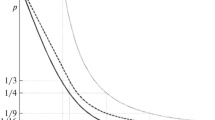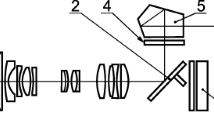Abstract
For deriving the robust estimation by the EM (expectation maximization) algorithm for a model, which is more general than the linear model, the nonlinear Gauss Helmert (GH) model is chosen. It contains the errors-in-variables model as a special case. The nonlinear GH model is difficult to handle because of the linearization and the Gauss Newton iterations. Approximate values for the observations have to be introduced for the linearization. Robust estimates by the EM algorithm based on the variance-inflation model and the mean-shift model have been derived for the linear model in case of homoscedasticity. To derive these two EM algorithms for the GH model, different variances are introduced for the observations and the expectations of the measurements defined by the linear model are replaced by the ones of the GH model. The two robust methods are applied to fit by the GH model a polynomial surface of second degree to the measured three-dimensional coordinates of a laser scanner. This results in detecting more outliers than by the linear model.
Similar content being viewed by others
References
Aitkin M, Wilson GT (1980) Mixture models, outliers, and the EM algorithm. Technometrics 22:325–331
Amiri-Simkooei A, Jazaeri S (2012) Weighted total least squares formulated by standard least squares theory. J Geodetic Sci 2:113–124
Baarda W (1968) A testing procedure for use in geodetic networks. Publications on Geodesy, vol. 2, nr. 5. Netherlands Geodetic Commission, Delft
Beckman RJ, Cook RD (1983) Outlier..s. Technometrics 25:119–149
Böck R (1961) Allgemeinste Formulierung der Ausgleichungsrechnung nach der Methode der kleinsten Quadratsummen. Zeitschrift für Vemessungswesen 86:43–45, 98–106
Dempster AP, Laird NM, Rubin DB (1977) Maximum likelihood from incomplete data via the EM algorithm. J Royal Statist Soc B 39:1–38
Fang X (2013) Weighted total least squares: necessary and sufficient conditions, fixed and random parameters. J Geodesy 87:733–749
Golub GH, Van Loan CF (1980) An analysis of the total least squares problem. SIAM J Numer Anal 17:883–893
Helmert FR (1872) Die Ausgleichungsrechnung nach der Methode der kleinsten Quadrate. Teubner, Leipzig
Huber PJ (1964) Robust estimation of a location parameter. Ann Math Statist 35:73–101
Huber PJ (1981) Robust statistics. Wiley, New York
Kargoll B, Krasbutter I (2013) An iteratively reweighted least squares approach to adaptive robust adjustment of parameters in linear regression models with autoregressive, t-distributed observation errors. J Geodesy (submitted)
Knight NL, Wang J, Rizos C (2010) Generalised measures of reliability for multiple outliers. J Geodesy 84:625–635
Koch KR (1999) Parameter estimation and hypothesis testing in linear models, 2nd edn. Springer, Berlin
Koch KR (2007) Introduction to Bayesian statistics, 2nd edn. Springer, Berlin
Koch KR (2011) Data compression by multi-scale representation of signals. J Appl Geodesy 5:1–12
Koch KR (2013a) Robust estimation by expectation maximization algorithm. J Geodesy 87:107–116
Koch KR (2013b) Comparison of two robust estimations by expectation maximization algorithms with Huber’s method and outlier tests. J Appl Geodesy 7:115–123
Koch KR, Kargoll B (2013) Expectation maximization algorithm for the variance-inflation model by applying the t-distribution. J Appl Geodesy 7:217–225
Koch KR, Kuhlmann H (2009) The impact of correcting measurements of laserscanners on the uncertainty of derived results. ZfV-Z Geodäsie, Geoinformation und Landmanagement 134:38–44
Lange JL, Little RJA, Taylor JMG (1989) Robust statistical modeling using the t distribution. J Am Statist Ass 84(408):881–896
Lehmann R, Neitzel F (2013) Testing the compatibility of constraints for parameters of a geodetic adjustment model. J Geodesy 87:555–566
Lehmann R, Scheffler T (2011) Monte Carlo-based data snooping with application to a geodetic network. J Appl Geodesy 5:123–134
Meng X, Rubin DB (1993) Maximum likelihood estimation via the ECM algorithm: a general framework. Biometrika 80(2):267–278
Neitzel F (2010) Generalization of total least-squares on example of unweighted and weighted 2D similarity transformation. J Geodesy 84:751–762
Pope AJ (1972) Some pitfalls to be avoided in the iterative adjustment of nonlinear problems. In: Proceedings of the 38th Annual Meeting of the American Society of Photogrammetry. Washington, D.C., pp 449–477
Pope AJ (1976) The statistics of residuals and the detection of outliers. NOAA Technical Report NOS65 NGS1. US Department of Commerce, National Geodetic Survey, Rockville
Schaffrin B, Wieser A (2008) On weighted total least-squares adjustment for linear regression. J Geodesy 82:415–421
Tukey JW (1960) A survey of sampling from contaminated distributions. In: Olkin I, Ghurye S, Hoeffding W, Madow W, Mann H (eds) Contributions to probability and statistics. Stanford University Press, Stanford, pp 448–485
Wolf H (1978) Das geodätische Gauß-Helmert-Modell und seine Eigenschaften. Z Vermessungswesen 103:41–43
Xu P, Liu J, Shi C (2012) Total least squares adjustment in partial errors-in-variables models: algorithm and statistical analysis. J Geodesy 86:661–675
Acknowledgments
The author is indebted to Wolf-Dieter Schuh for his valuable comments.
Author information
Authors and Affiliations
Corresponding author
Rights and permissions
About this article
Cite this article
Koch, KR. Robust estimations for the nonlinear Gauss Helmert model by the expectation maximization algorithm. J Geod 88, 263–271 (2014). https://doi.org/10.1007/s00190-013-0681-9
Received:
Accepted:
Published:
Issue Date:
DOI: https://doi.org/10.1007/s00190-013-0681-9




